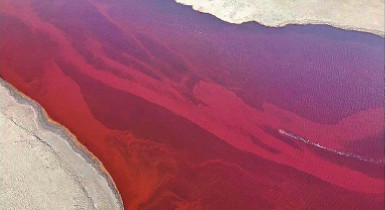Russia on Thursday intensified efforts to clean up a major fuel spill that environmentalists say is the worst such accident in the Arctic, as investigators made their first arrest.
A diesel reservoir collapsed at a power station outside the northern Siberian city of Norilsk on Friday, releasing 15,000 tonnes of fuel into a river and 6,000 tonnes into the soil, according to Russia’s state environmental watchdog.
President Vladimir Putin has ordered a state of emergency to deal with the disaster.
On Wednesday he furiously criticised the delay in the cleanup response, while Norilsk Nickel, the metals giant that owns the collapsed fuel reservoir through a subsidiary, insists it notified the proper agencies immediately.
Greenpeace Russia said the accident was the “first accident of such a scale in the Arctic” and comparable to the Exxon Valdez disaster off the coast of Alaska in 1989.
Russia’s Investigative Committee said a power station supervisor has been detained and will be charged shortly as it conducts three probes into environmental pollution and safety violations.
No information was given about the possible charges against the employee.
Scale of catastrophe underestimated
Reinforcements arrived at the remote location on Thursday, said Andrei Malov, spokesman for Russia’s Marine Rescue Service, which cleans up marine spills and was called in at the weekend.
“There haven’t been such spills in the Arctic before,” he told AFP. “It needs to be collected very quickly because the fuel is dissolving in the water.”
The Ambarnaya River, which is affected by the spill, feeds into Lake Pyasino, a major body of water and the source of the Pyasina River that is vitally important to the entire Taimyr peninsula.
Russian fisheries agency spokesman Dmitry Klokov said restoring the polluted water system would take “decades”.
“The scope of this catastrophe is being underestimated,” he told TASS news agency, adding that most of the fuel had sunk to the bottom of the river and already reached the lake.
Malov said the marine rescue service has put up six oil containment booms in the Ambarnaya River to stop the diesel fuel going into the lake and was using special devices to skim off the fuel.
But the clean-up mission is being hampered by the lack of roads in the area and windy weather that has already caused blocks of ice to breach the barriers, releasing more fuel towards the lake, and forcing responders to reposition them, Malov said.
“It’s swampy territory, and everything can only be delivered there on all-terrain vehicles,” Malov said, predicting that the collected fuel will have to stay on site until the winter in special tanks.
Permafrost melted
Prosecutors in Krasnoyarsk region said in a statement that the spill also polluted 180,000 square metres of land before hitting the river.
Norilsk Nickel said the accident possibly occurred because the ground under the fuel reservoir subsided as the permafrost melted due to climate change.
WWF expert Alexei Knizhnikov said that while climate change does affect permafrost, the accident wouldn’t have happened if the company followed the rules.
By Russian law, there should be a containment structure around any fuel reservoir that would have kept most of the spillage on site, he said.
“A lot of the blame lies with the company,” he added.
The difficult terrain prompted some officials to suggest the collected fuel should be burned off at the scene, but Russia’s environmental watchdog chief Svetlana Radionova on Thursday ruled this out.
“There will not be any burning of the petroleum products,” she was quoted by Interfax news agency as saying, also promising to consult with the scientific community on the best course of action.
Article Source Link: ScienceAlert

